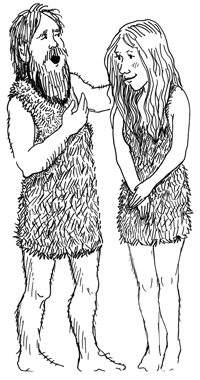STRANGE BUT TRUE- Safe passage: Where we got our lovin' feelin'

DRAWING BY DEBORAH DERR McCLINTOCK
Q. From an evolutionary standpoint, what's the nub of romantic love? –J. Keats
A. When human moms began walking upright long ago, the size of the pelvis shrank somewhat, making birth clearances tougher, theorizes Rutgers University anthropologist Helen Fisher. In response, babies started being born before their heads were fully developed, which put a high premium on the head "ballooning" period of childhood, reports Kate Wong in Scientific American. And in turn, longer childhoods necessitated stronger and more long-term bonding between moms and dads in order to see their progeny through to a safe stage. And the smarter big-headed kids made for a smarter species overall, capable of more developed modes of wooing one another– through poetry, music, art and dance.
"The archaeological record indicates that by 35,000 years ago, humans were engaging in these sorts of behaviors. Which is to say," says Wong, "they were probably just as lovesick as we are."
Q. Though English spellings are notorious for their irregularities and exceptions, how are people today voting with their fingers for real spelling reform? –D. McNair
A. Which "people"? In Middle English, the word had a variety of spellings, such as peple, pepule, pepille and pepyll, says David Crystal in Walking English: A Journey in Search of Language.
Today there are spelling principles that can be learned but none of them work all the time. We are bedeviled by "silent letters," as in debt and island, or by non-phonic words like the, of, one, two, could, should, might, ought and write– among the most frequently used in the language. These just have to be learned as wholes.
"You will never solve the spelling of 'could' by trying to relate its letters to its sounds."
Generally, American English is still stuck with what Noah Webster introduced in the late 1700s. Or is it? The Internet may be changing things in a rather grand way. Most of the writing we see in emails, chatrooms, instant messaging, texting and blogging has received no adulteration by editors but is written English in its most naked form, incorporating such simplifications as rubarb, autum and zylophone. Typing "peple" into Google will get hundreds of thousands of hits; a few are proper names but most aren't.
"Did you mean to search for 'people'?" asks the Google software, wistfully.
"These new spellings have little influence at the moment, but how about in 50 or 100 years?" asks Crystal. "Might some of them come to be universally adopted? I think so."
Q. What's some really GR8 news for worried parents in these days of the exploding Internet, emailing, cell-phoning, YouTubing, tweeting and the like? –M. Goose
A. It's that "txting cn b gd 4 ur kds," and that "textisms" like "CUL8R" and "wot u doin 2nite?" not only don't hurt children's reading and spelling abilities but may help them along due to all the linguistic attention and abbreviations, says New Scientist magazine. For example, when Beverly Plester of Coventry University in the U.K. had 88 children aged 10-12 write text messages describing ten different scenarios, she found that those who used more textisms were also the better readers. But which caused which? Plester believes the textisms aid reading because they are phonetically based. "Phonological awareness has long been associated with good reading skills," she says. "These kids are engaging with more written language and they're doing it for fun." Concludes New Scientist: "Exposure to the written word in any form tends to enhance literacy."
Q. Problem: You're a 53-foot, 72-ton humpback whale with a half-ton stomach capacity that requires four fill-ups a day. How in the seaworld are you going to scare up that much food? –R. McDonald
A. By "corralling" before gulping, explains Neil A Campbell in Biology: Concepts and Connection. Beginning some 70 feet below the surface, the humpback swims upward in a large spiral, blowing bursts of air bubbles as it goes.
These rise in vertical columns to the surface, forming a kind of cylindrical bubble cage that traps small fish and crustaceans. They could swim through the bubbles but instead swim away from them, clustering toward the center.
Now they're lined up for the big swallow: The 72-tonner powers up through the cylinder, harvesting a whale of a mouthful.
Q. Been "bugged" by UFO's lately? –R. Serling
A. When large swarms of insects pass through an electrified region of a storm front or near crystalline rocks that create a piezoelectric effect, the bugs may become luminous, reports Leonard George in Alternative Realities.
Pointed structures on the insects' exoskeletons gather electricity, which is then discharged into the air as tiny flares. When researchers placed predatory stink bugs in an electric field, they gave off brilliant discharges of red, blue, and green light.
A huge swarm flying suddenly into a charged area could "become visible as a humming cloud of millions of glowing specks," then go suddenly dark as the bugs leave– a common feature of UFO sightings. Also UFO-like, the "object" would be accompanied by widespread reports of disruption to electromagnetic devices such as radio and TV.
~
Send Strange questions to brothers Bill and Rich at [email protected].
#